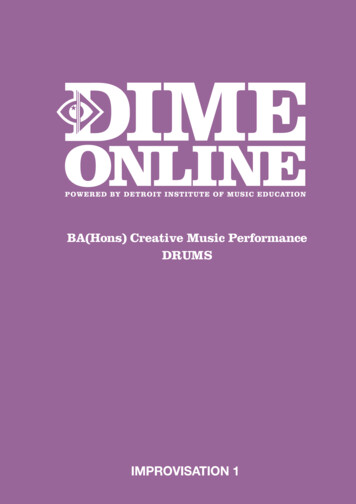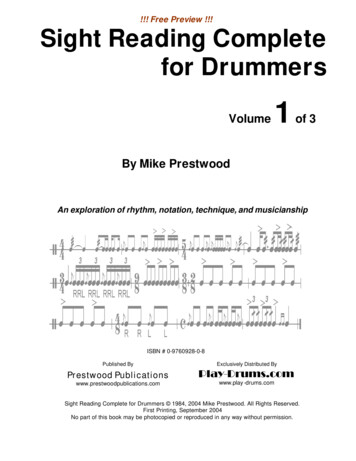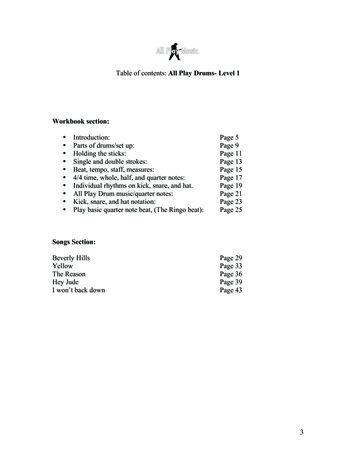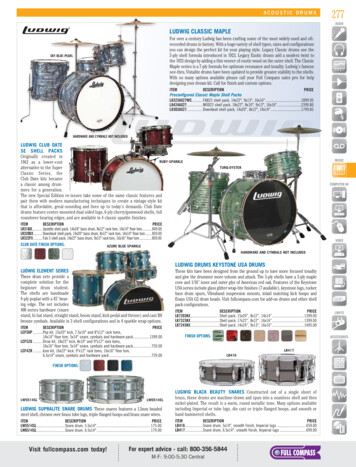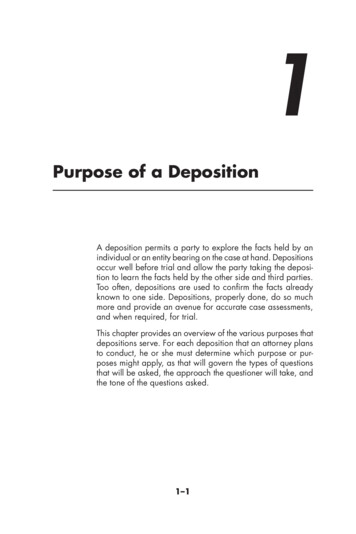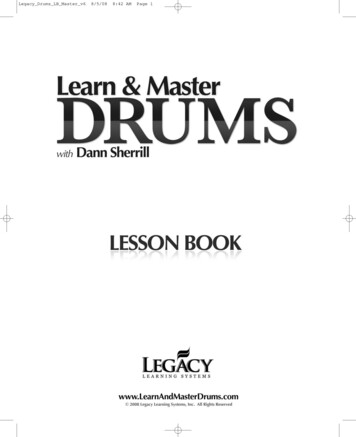
Transcription
Legacy Drums LB Master v68/5/088:42 AMPage 1
Legacy Drums LB Master v68/5/088:42 AMPage 2Table of ContentsSESSIONS1) Starting Off RightPAGE4Playing the Bass Drum, Heel Down Position, Heel Up Position,Bass Drum Exercises, Setting Up the Snare Drum, Proper HandMovement, Gripping the Drumstick, Developing a ReboundingStroke, Basic Rebound Strokes2) Basics of the Beat9135) Expanding on the Basics1924297) Basic Rock Beats348) The Jazz Ride & Brushes39The Jazz Ride Pattern, Four Positions of the Jazz Ride,Playing with Brushes9) Jazz Coordination42Single Stroke Roll, Closed Rolls,Open Rolls, Rolls Exercises76Time, Groove & Pocket, Improving Your Time Practice Ideas, TheNote Tree Exercise, The Jazz Ride Meditation, The CharlestonWarm Down, The 20 Minute Groove, Making the Most of YourMetronome80Double Bass Drum Technique, Alternating Strokes, Latin Variations,Enhanced Rock Grooves, Sixteenth Note Variations, Bass DrumReinforcement, Double Bass Fills, Double Bass Shuffles, LatinDouble Bass Grooves86New Orleans Drumming, Second Line & New Orleans Beats,R & B Beats, Motown Beats, Memphis Rock Beats, FunkBeats, Modern Beats, Half Time Grooves, Hip Hop Beats91Latin Drumming, Clave, The 6/8 and Cut Time Relationship,Rumba Clave, Son Clave, The Tumbao, Ponche, Bombo Note &the Cascara Rhythm, Cha-Cha, Songo, Brazilian Music,Samba, Reggae Beats20) Song Structure & Musicality9721) Soloing100Free Form Soloing, Soloing Over Song Form, Working Out a Solovs. Improvising, Soloing Over an Ostinato, Exploring AlternativeSounds, Trading Fours in Jazz22) Beyond Drumming Technique48Rudiments, Grace Notes, Ruffs and Drags, Flams, Paradiddles,Swiss Rudiments, Applying Rudiments to the Drumset11) Rolls71Song Structure, Jazz Song Form, Writing a Drum Chart, DrumFigures, Drum Set UpsJazz Coordination & Independence, Two Way Jazz Coordination,Charleston Rhythm, Three Way Jazz Coordination, Three BarExercises, Triplets Between Bass & Snare,Four Way Jazz Coordination, Jazz Coordination Using theReading Pages10) Rudiments68Advanced Sticking, Type A Stickings, Type A Stickings in 16thNotes Exercises, Type A Stickings in Triplets Exercises,Type BStickings, Type C Stickings, Linear Drumming, LinearDrumming Sequence19) Latin, Brazilian & Reggae DrummingIntroduction to Rock Drumming, Basic Rock Beats, The MoneyBeat, 2 Bar Rock Grooves, Early Rock Beats63Rock Systems, Systems with Hi-Hat Eighth Notes, SnareBackbeats & Melody on Bass Drum, Advanced Rock Systems18) New Orleans and R & B DrummingBlues & Shuffle Basics, Blues Shuffle Beats, 12/8 Blues Beats,Blues Dynamics57Introduction to Fills, Tips for Playing Fills, Developing Coordination,Playing in Shapes, Three Over Two Phrases, Practical Drum Fills17) Double Bass DrummingSnare Alternating 16th Notes, Alternating 16thNote Snare Drum Exercises, Dynamics in Music, Accents,Accented Alternating 16th Note Exercises, 16ths withBass Drum and Hi-Hat Exercises, Variations on the Bo Diddley Beat6) Blues & Shuffles13) Drum Fills16) Time, Groove & PocketRide Cymbal Technique, Drum Notation, Coordination with Bass,Snare and Hi-Hat, Quarter Note Ride Cymbal Exercises, EighthNote Ride Cymbal Exercises, Playing the Bell of the Ride CymbalPAGEThe Fundamental Moeller Strokes: the Downstroke, theTap and the Upstroke, Moeller Technique Practice, Moeller TripletExercises, Moeller Sixteenth Note Exercises15) Advanced Sticking & Linear DrummingThe Basics of Reading Music, Clefs, Notes, and Rests, TimeSignatures, The Note Tree, Dotted Notes, Musical Terms,Straight vs. Swing Beats, Music Reading Using the Reading Pages4) The Ride Cymbal12) Moeller Technique14) Advanced Rock CoordinationIntroduction to the Hi-Hat, Hi-Hat Exercises, Playing the BassDrum and Hi-Hat Together, Adding the Snare Drum, The Motherof All Beats, Subdividing the Beat: Quarters, 8ths and 16ths,Alternating Sixteenth Notes, The Dance Beat3) Musical NotationSESSIONS53103Left-Right-Right Running Pattern, The Never-Ending Charleston,The Eight CombinationsQuarter Note Reading PageEighth Note Reading Page 1Eighth Note Reading Page 2Sixteenth Note Reading Page108109110111
Legacy Drums LB Master v68/5/088:42 AMPage 3Learn & Master DrumsPlay-Along CD TracksCD 1CD 4Blues & Early Rock 1Soul and R & B1.2.3.4.5.6.7.8.9.10.Slow Blues (12/8 Blues) 8th Note 160 bpmSlow Blues - Minus DrumsGut Bucket (12/8 Blues) 100 bpmGut Bucket - Minus DrumsTexas Shuffle (Texas Shuffle Blues) 128 bpmTexas Shuffle - Minus DrumsLa Grunge (Fast Driving Shuffle) 150 bpmLa Grunge - Minus DrumsO Jeraldine (50’s Rock & Roll) 141 bpmO Jeraldine - Minus CD 2Blues & Early Rock 21. When the Saints Go Marching In (New Orleans Gospel 2 Beat)Half Note 120 bpm2. When the Saints Go Marching In - Minus Drums3. I Hear Ya Fats (12/8 50’s New Orleans Rock) 90 bpm4. I Hear Ya Fats - Minus Drums5. Great Googly Moogly (50’s New Orleans Rock) 152 bpm6. Great Googly Moogly - Minus Drums7. Little Lucy (50’s New Orleans Rock) 135 bpm8. Little Lucy - Minus Drums9. Baby Huey (50’s Slow New Orleans Rock/New Orleans Mambo)116 bpm10. Baby Huey - Minus Drums11. Hey Wocky Pay (New Orleans Funk) 90 bpm12. Hey Wocky Pay - Minus DrumsCD 5Soul and R & B, Jazz & Brazilian1.2.3.4.5.6.7.8.9.CD 3Basic Rock, 60's Rock & Modern 4.15.16.17.18.Detroit Rock & Roll (60’s Rock & Roll) 135 bpmDetroit Rock & Roll - Minus DrumsYou Rascal You (60’s Fast Rock & Roll) 182 bpmYou Rascal You - Minus DrumsI Don't Want To Know (80’s Rock) 113 bpmI Don't Want To Know - Minus DrumsMysticized (70’s R&B Jazz Fusion) 121 bpmMysticized - Minus DrumsDo You Know Jack (70’s Rock) 121 bpmDo You Know Jack - Minus DrumsRock n' Mo (Modern Rock) 121 bpmRock n' Mo - Minus DrumsRock My World (Modern Rock) 126 bpmRock My World - Minus DrumsPlay-Along CD TracksStay with Me (70’s Memphis Soul) 102 bpmStay with Me - Minus DrumsPerfume (Shuffle Funk) 80 bpmPerfume - Minus DrumsJ.B. Machine (60’s Funk) 110 bpmJ.B. Machine - Minus DrumsNo Sweat (60’s Funk) 116 bpmNo Sweat - Minus DrumsHold Up (60’s Memphis Soul) 102 bpmHold Up - Minus DrumsLivin' Single (80’s Funk) 112 bpmLivin' Single - Minus DrumsY B Cruel (80’s Funk) 100 bpmY B Cruel - Minus DrumsAir (70’s R&B) 86 bpmAir - Minus DrumsEmily (Half Time 70’s Shuffle Funk) 116 bpmEmily - Minus Drums3Bullabunga (Modern Funk) 81 bpmBullabunga - Minus DrumsKill Joy (Medium Swing) 106 bpmKill Joy - Minus DrumsBull's Bash (Swing Blues) 115 bpmBull's Bash - Minus DrumsGoosy Lucy (Medium Swing) 135 bpmGoosy Lucy - Minus DrumsSomeday My Prints Will Come (3/4 Jazz Waltz)134 bpmSomeday My Prints Will Come - Minus DrumsThis is Real (Bossa Nova) 112 bpmThis Is Real - Minus DrumsThe Dream (Bossa Nova) 118 bpmThe Dream - Minus DrumsOnce Dropped (One Drop Reggae) 148 bpmOnce Dropped - Minus DrumsWinter (Latin/Funk Fusion) 91 bpmWinter - Minus Drums
Legacy Drums LB Master v68/5/088:42 AMPage 4Learn & Master DrumsSESSION 1 - Starting Off RightEstimated Time to Learn These Concepts - 1 Week“If thine enemy wrongs thee, buy each of his children a drum.” UnknownKEY CONCEPTSSKILLS TO MASTER Playing the Bass Drum Setting Up the Snare Drum Proper Hand Movement Basic Rebound Strokes Playing the bass drum with good technique. Holding the sticks properly with a loose grip. Playing the snare drum using proper technique. Counting and playing the bass drum while playing 8thnotes on the snare.Playing the Bass DrumThe bass drum is the foundation of the drumset. The basic function of the bass drum is to state the beat or pulse of the song.The BASS DRUM is played with the bass drum pedal by the right foot. The bass drum pedal beater should rebound off of thebass drum head like a bouncing ball. Properly adjusting the angle of the bass drum pedal beater is important to playing comfortably. In general, angling the beater around the 2 o'clock position is a good place to start. After the pedal is attached to the bassdrum, position yourself so that your right knee is bent at a slightly greater than 90 degree angle when your foot is on the pedal.There are two basic techniques of playing the bass drum–HEELUP and HEEL DOWN. It is important to learn both techniques.Both use a rebound stroke where the beater strikes the bassdrum head then bounce back to the “at rest” position.Beater PositionAngle of the KneeHeel Down PositionIn the HEEL DOWN position, the heel of the right foot is in constant contact with the bass drumpedal when striking the bass drum. This position works best for achieving delicacy in your bassdrum playing and is mostly used when playing soft passages or slow songs called ballads.Heel Down PositionHeel Up PositionThe HEEL UP position uses the front part or “ball” of the foot to press the bass drum pedal. Thisposition works great when playing Rock and Funk or any heavy kind of music where a strong powerful bass drum hit is desired. To get the rebound or bounce while playing with the heel up, immediately return the heel to the footboard, but only for a moment.Heel Up PositionPlaying Tip: Keep it RelaxedRemember to relax at all times. There should be no stress ortension anywhere in your body while playing.Session 1Key Idea: Pulse and BeatThe words Pulse and Beat will be used often and mean the same thing–thefundamental rhythm or beat of the song. It's what you tap your feet to.4Starting Off Right
Legacy Drums LB Master v68/5/088:42 AMPage 5Learn & Master DrumsBass Drum ExercisesNow that you know the proper technique for playing the bass drum and getting a good rebound, practice the followingexercises. Practice playing a steady beat on the bass drum using the heel down technique. Then use the heel up technique. Once you can play a steady beat using both techniques try to find the beat and play along with Play-Along CD 3,Tracks 11 & 12, “Rock n' Mo.”Playing Tip: The Play-Along TracksEach song on the play-along CDs has two versions. The firstversion plays the song with the drums. The second versiondoes not have the drums, but a click track is provided to helpyou keep the tempo.Play-Along SongsThe Bass Drum exercises can be practiced withCD 3, TRACK 11 - “Rock n’ Mo”CD 3, TRACK 12 - “Rock n’ Mo” minus DrumsBass Drum Exercise 1Play the Bass Drum using the heel down technique, then using the heel up technique.Bass Drum Exercise 2Play the pulse for 4 beats, then double pulse for 4 beats.Setting Up the Snare DrumPlaying Tip: Using a Click TrackThe SNARE DRUM has metal wires called snares attached to the bottom head. Itrests in the stand’s cradle without being clamped down. The height affects thecomfort level of the drummer, so set the height where your hands are comfortable and your shoulders are relaxed. Angle the snare drum back toward you.The click track on “Rock n' Mo” plays attwice the note rate of the beat of the song.Subdividing the click into smaller segmentsthan the beat helps musicians stay in tempo(keep the beat) on slower songs.Proper Hand MovementWhen playing the drums, your hands should move in a motion similar to waving good-bye or bouncing a basketball. Placeyour hands in front of you, palms down, and flex at the wrist. Practice this motion without sticks, one hand at a time.1.Session 12.3.5Starting Off Right
Legacy Drums LB Master v68/5/088:42 AMPage 6Learn & Master DrumsLearning proper hand technique will enable you to1. Maximize your rebound2. Get a good, beefy sound3. Maximize your ability to transfer your ideas from your brain to the drums with minimum effortGripping the DrumstickThe DRUMSTICK has four basic parts: the BUTT, the SHAFT, the SHOULDER, and the TIP.ButtShaftShoulderTipFulcrumThe BUTT is the end of the stick and can be used to strike the snare drum when a more powerful sound is required, as inheavier Rock or Funk. The SHAFT is the part of the stick that the player grips. The SHOULDER is the part of the stick thattapers down to the tip. The TIP is the main playing end of the stick.Hold the stick between your thumb and index finger about 2/3 of the way from the tip at a point called the fulcrum. TheFULCRUM is the perfect balance point of the drumstick and is the optimum place for gripping the sticks to achieve maximum bounce or rebound. The hand should grip the stick at the fulcrum loosely. Both hands should grip the sticks identically forming a MATCHED GRIP.Developing a Rebounding StrokeNow, let's learn the proper way to strike a drum. Take the sticks and form your grip. The stroke we will employ makes useof the fingers, wrist, forearm, and elbow. You will make a whip-like motion similar to cracking a whip or casting a fishingrod. Here is how the stroke should look.1.2.Start with both sticks in an at-restposition using a loose matched grip.Bring elbow down first, deadweightfashion, creating a whipping motion.Session 1Raise elbow and forearm oflead hand.The stick strikes drum.63.The lead wrist and hand follow.The stick rebounds off the drum.Starting Off Right
Legacy Drums LB Master v68/5/088:42 AMPage 7Learn & Master DrumsPractice this motion first without striking the drums, like “air drums,” then practice playing the snare drum with a properrebounding stroke. Strike the snare drum dead center to get a full sound. Maximizing rebound allows the sticks to do thework, not the drummer.Key Idea: Maintain a Relaxed GripBasic Rebound StrokesRemember, the sticks are our connection to theinstrument so it is important to have a relaxedgrip and a proper stroke in order to get a goodsound out of the drum.Practice the following exercises on the snare drum using a properrebounding stroke and a loose grip.Exercise 1Play the Snare on the beat with the right hand first, then the left hand.Exercise 2Play the Snare doubling the beat, alternating hands.Once you can play a steady beat on the snare drum with good technique play along with Play-Along CD 4, Track 2. Exercise3 is the same rhythm as Exercise 2, played with the track.Play-Along SongsExercise 3Play with the track, the Snare doubling the beat, alternating hands.Exer
drum, position yourself so that your right knee is bent at a slightly greater than 90 degree angle when your foot is on the pedal. There are two basic techniques of playing the bass drum–HEEL UPand HEEL DOWN.It is important to learn both techniques. Both use a rebound stroke where the beater strikes the bass drum head then bounce back to the “at rest” position. Beater Position Angle of .

